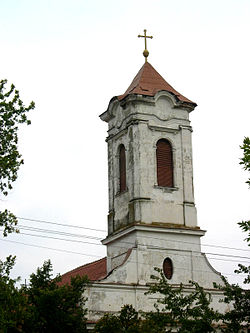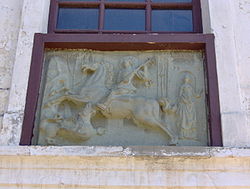- Žitište
-
Žitište
Житиште
Bégaszentgyörgy— Municipality and Town — Building in town center. 
Coat of armsLocation of the municipality of Žitište within Serbia Coordinates: 45°29′N 20°33′E / 45.483°N 20.55°E Country Serbia District Central Banat Settlements 12 Government – Mayor Dragan Milenković - Democratic Party Area[1] – Municipality 525 km2 (202.7 sq mi) Population (2011 census)[2] – Town 3,242 – Municipality 20,399 Time zone CET (UTC+1) – Summer (DST) CEST (UTC+2) Postal code 23210 Area code +381 23 Car plates ZR Website zitiste.org Žitište (Serbian Cyrillic: Житиште, Hungarian: Bégaszentgyörgy or Begaszentgyörgy) is a town and municipality in Central Banat District of Vojvodina, Serbia. The town has a population of 3,236, while Žitište municipality has 20,144 inhabitants.
Contents
Name
In Serbian, the town is known as Žitište (Cyrillic: Житиште), in Romanian as Jitişte or Zitişte, in German as Sankt Georgen an der Bega, and in Hungarian as Bégaszentgyörgy.
The original name of the town derived from the Hungarian family name Szentgyörgyi.
The Serbian name of the town derived from the Serbian word "žito" ("wheat" in English). Its old names used in Serbian were Begej Sveti Đurađ and Senđurađ.
Serbian, Hungarian, and Romanian language are officially used by municipal authorities.
History
It was founded in the 14th century during the Hungarian Kingdom, under Zenthgyurgh (Szentgyörgyi) name. In 1660/1666, Senđurađ was recorded as settlement repopulated by ethnic Serbs during Ottoman rule. In the beginning of the 18th century, settlement was completelly abandoned and in 1723 it was recorded as an uninhabited heath.
It was settled again in 1724 by Serb and Romanian settlers. In 1736/37, settlement had 27 houses. Because of the Austro-Turkish war (1736–1739) and pestilence, number of inhabitants decreased and in 1740 the population of the settlement numbered 18 houses. In 1753, Begej Sveti Đurađ was settled by 1,000 Serb frontiersmen from Pomorišje, Potisje and Veliki Bečkerek, and in the same year it was recorded on map as "Serb-inhabited settlement"[citation needed]. In 1758, Begej Sveti Đurađ had 45 houses, and in 1773 it had 182 houses. Church was built in 1758, and it was also used as a school. In 1781, Begej Sveti Đurađ became a property of Isak Kiš (Kis Izsák), who was a trader of Armenian origin.
In 1800-1805, the settlement was moved to another location closer to the Begej river. Part of the Serb population moved from the settlement and settled in Military Frontier, while German colonists settled in Begej Sveti Đurađ instead of them. Begej Sveti Đurađ was a municipality until 1877, when it was joined to the municipality of Veliki Bečkerek. In 1880, the population of the settlement numbered 3,041 people, of whom 1,983 were Catholics, 1,033 were Orthodox, 19 were Jews, and 6 were others. In accordance with the census made in 1910, the linguistic distribution of the 2,814 inhabitants was the following: 1,454 who spoke German language, 1,034 who spoke Serbian language and 214 who spoke Hungarian language.
In 1931, population of Begej Sveti Đurađ included 1,318 inhabitants who spoke German language, 1,055 who spoke Serbian language, 188 who spoke Hungarian language, 34 who spoke other Slavic languages, and 94 who spoke other languages. In 1940, population of Begej Sveti Đurađ numbered 3,055 people, of whom 1,642 were Orthodox, 1,387 were Catholics, 16 were Jews, and 10 were others.
As a consequence of World War II and Axis occupation, German population left or was evicted from Begej Sveti Đurađ after the war, while 270 Serb families from Bosanska Krajina came to the settlement. In 1947, the name of the settlement was officially changed to Žitište. In 1960, Žitište became a seat of municipality.
Inhabited places
Žitište municipality includes the town of Žitište and the following villages:
- Banatski Dvor (Hungarian: Szőllősudvarnok)
- Banatsko Višnjićevo
- Banatsko Karađorđevo
- Međa
- Novi Itebej (Hungarian: Magyarittabé)
- Ravni Topolovac
- Srpski Itebej
- Torak (Romanian: Torac)
- Torda (Hungarian: Torontáltorda)
- Hetin (Hungarian: Tamásfalva or Hetény)
- Čestereg
Demographics (2002 census)
Ethnic groups in the Žitište municipality
- Serbs = 12,628 (61.9%)
- Hungarians = 4,017 (19.69%)
- Romanians = 1,837 (9%)
- Roma = 765 (3.75%)
- Yugoslavs = 266 (1.3%)
- others.
Settlements by ethnic majority
Settlements with Serb ethnic majority are: Žitište, Banatsko Višnjićevo, Banatsko Karađorđevo, Međa, Ravni Topolovac, Srpski Itebej, and Čestereg. Settlements with Hungarian ethnic majority are: Novi Itebej (Magyarittabé in Hungarian), Torda, and Hetin (Tamásfalva in Hungarian). The settlement with Romanian ethnic majority is Torak (Begejci). Ethnically mixed settlement with relative Serb majority is Banatski Dvor (Szőllősudvarnok in Hungarian).
Ethnic groups in the Žitište town
- Serbs = 2,861 (88.25%)
- Roma = 156 (4.81%)
- Hungarians = 70 (2.16%)
- Yugoslavs = 32 (0.99%)
- Romanians = 29 (0.90%)
- others.
Notable inhabitants
Historical population
Population of the town in different censuses:
- 1948: 3,163
- 1953: 3,326
- 1961: 3,078
- 1971: 2,921
- 1981: 3,060
- 1991: 3,074
- 2002: 3,242
Politics
Seats in the municipality parliament won in the 2008 local elections:
- Democratic Party (7)
- Serbian Radical Party (6)
- Socialist Party of Serbia (4)
- Democratic Party of Serbia (4)
- Alliance of Vojvodina Hungarians (3)
- LSV (3)
- New Serbia (2)
- G17 Plus (2)
Trivia
In 2007 local authorities unveiled a monument in the centre of the town, dedicated to famous, fictional boxer Rocky Balboa. [1]
See also
- List of places in Serbia
- List of cities, towns and villages in Vojvodina
References
- Ljubica Budać, Begej Sveti Đurađ - Žitište, Žitište, 2000.
- Slobodan Ćurčić, Broj stanovnika Vojvodine, Novi Sad, 1996.
- ^ "Municipalities of Serbia, 2006". Statistical Office of Serbia. http://webrzs.stat.gov.rs/axd/en/Zip/OG2006webE.zip. Retrieved 2010-11-28.
- ^ "2011 Census of Population, Households and Dwellings in the Republic of Serbia – FIRST RESULTS". Bulletin (Statistical Office of the Republic of Serbia) 540. 2011. ISSN 0354-3641. http://media.popis2011.stat.rs/2011/prvi_rezultati.pdf. Retrieved 2011-11-21.
External links
Cities, towns and villages in the Central Banat District Zrenjanin: Aradac • Banatski Despotovac • Belo Blato • Botoš • Elemir • Ečka • Jankov Most • Klek • Knićanin • Lazarevo • Lukino Selo • Lukićevo • Melenci • Mihajlovo • Orlovat • Perlez • Stajićevo • Taraš • Tomaševac • Farkaždin • Čenta
Žitište: Banatski Dvor • Banatsko Višnjićevo • Banatsko Karađorđevo • Međa • Novi Itebej • Ravni Topolovac • Srpski Itebej • Torak • Torda • Hetin • Čestereg
Nova Crnja: Aleksandrovo • Vojvoda Stepa • Radojevo • Srpska Crnja • Toba
Novi Bečej: Bočar • Kumane • Novo Miloševo
Sečanj: Banatska Dubica • Boka • Busenje • Jarkovac • Jaša Tomić • Konak • Krajišnik • Neuzina • Sutjeska • Šurjan
(*) bold are municipalitiesCategories:- Places in Serbian Banat
- Populated places in Vojvodina
- Municipalities of Vojvodina
Wikimedia Foundation. 2010.










